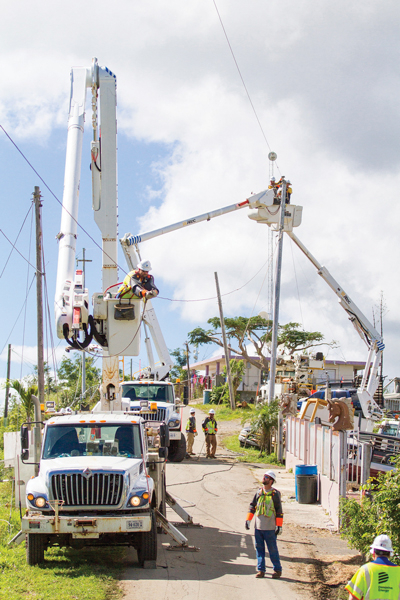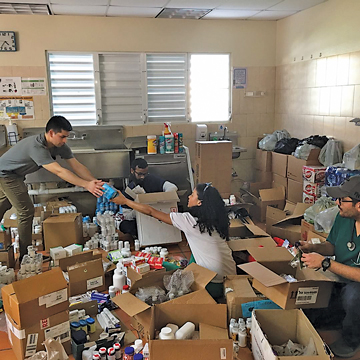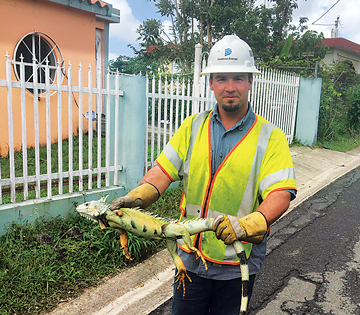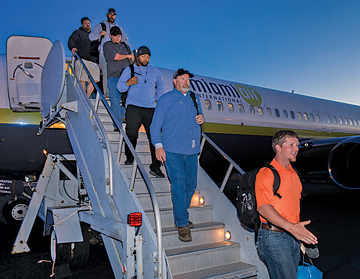Looking out the jet window at the island below, Thomas Irving had no idea what to expect when the plane finally landed in storm-ravaged Puerto Rico. Irving, a Dominion Energy operations manager for Virginia Beach and Norfolk, was part of the advance crew headed to the island in mid-January to help with power restoration efforts five months after devastating Hurricane Maria.
Irving, who was serving as a field manager on this trip, was one of eighty-two Dominion Energy employees who volunteered for the month-long humanitarian deployment. He remembers the first time he helped people here on the homeland get their lights on after a hurricane. “There’s no better feeling than to go out and know you can make a difference,” says the 30-year Dominion veteran. “Helping people really gets in
your blood.”
After landing, as Irving rode out to the hard-hit area of Carolina (about thirty miles northeast of San Juan), he was surprised to see the mountainous terrain. “I had no idea there were mountains,” he says. “The roads there are very narrow, and iguanas will go across the road. It’s beautiful country with a lot of greenery. I was in awe of all of that.”
 He was no less dumbfounded after surveying the damage to the power lines. “By the fifth month after the hurricane, you would think the main lines would be repaired, but we were still seeing main line devastation,” he says. “There was still a lot of work to be done. We were taken aback by that.”
He was no less dumbfounded after surveying the damage to the power lines. “By the fifth month after the hurricane, you would think the main lines would be repaired, but we were still seeing main line devastation,” he says. “There was still a lot of work to be done. We were taken aback by that.”
What Irving saw as he got deeper into the area where the hurricane had lingered and caused mass destruction was unbelievable.
“There were tall 14-inch-square concrete poles that had broken in half during the hurricane … rows of them going down the road. Major highway signs were lifted out of the ground and thrown in ditches,” he says. “We had never witnessed any hurricane-strength winds before that would have done that.”
Alec Hagerman, a customer project designer for Dominion in Richmond, had the same “wow” moment when he arrived in Puerto Rico a few days later with the rest of the volunteers. “I had never seen anything like it,” he says. “Whole commercial steel beams in a structure were twisted like someone was tying a knot. Palm trees were uprooted. One of the locals said he had measured the winds at 251 miles per hour.”
Hagerman had visited Puerto Rico several times on cruises, but this was an entirely different experience. “We had no idea what it would entail to rebuild this,” he says of the power lines. “It was difficult to judge what was there. The vegetation grows at a tremendous rate. There were conductors on the ground. You would walk past a pole or a live wire on the ground and never know it was there.”
Being in a rainforest made the effort even more challenging. “There were snakes – boas in the trees,” Irving says. “One of the residents told us you could clear a path and in a month it would have grown back up.”
To make the job even more challenging, the mountains in that region were too steep for vehicles to maneuver. “A lot of times, you were driving right along a cliff,” Irving says. “Getting to some of the areas was impossible. My heart really felt for these people.”
The summer climate brought with it 90-degree days dripping with humidity, something Irving’s body had to adjust to after leaving snowy Virginia in January. Torrential downpours followed by blazing sun and blistering heat were daily occurrences.
Dominion crews worked 14-hour days, seven days a week – trying to restore power. The bright spot in the midst of the destruction was the reception they got from locals, many of whom insisted on cooking for the crews. “We had families arguing about who would cook for us. Their generosity was over the top,” Irving says. “They would cook on wood or propane, and usually they would cook beans, rice, and chicken. The guys really appreciated that.”
The crews would finish up in one area and then cross the mountain to continue working, and the locals weren’t far behind. “They made their way across the mountain to feed us,” Irving says.
Both men said that on every project, no matter how long the Dominion Energy crews were on the job, someone in the community would come up to them to say hello. “They would offer us a bottle of their water, and they might only have two bottles for themselves for a week,” Hagerman says.
History Speaks Volumes
Puerto Rican Alicia Díaz, assistant professor of dance with the Department of Theatre and Dance at University of Richmond, understands the community pride from Puerto Ricans even in the midst of disaster. She is saddened by the effects of the hurricane, but recognizes it wasn’t just the savage winds that brought down the island’s ability to bounce back.

The island was going through a deep political and financial crisis long before the hurricane. To understand the depth, one must understand the island’s history.
Puerto Rico became a colony in 1898 when the U.S. acquired the island at the end of the Spanish-American War under the terms of the Treaty of Paris. It became an unincorporated territory in 1952 under President Truman.
The U.S. imposed American citizenship in 1917 when it passed the Jones Act. “It’s important to understand that Puerto Ricans are American citizens, but they are not allowed to vote for president of the United States,” Díaz says. “There is no congressional representation from Puerto Rico. Since 1917, Puerto Ricans have served in all American wars.”
The history of Puerto Rico is important, but it’s not something “we learn in our history classes here in the United States,” adds Diaz. “It’s hidden in plain sight.”
During President Obama’s administration, Congress established a fiscal control board that has broad sovereign powers over Puerto Rico. The President appoints the members of the board. “The Puerto Rican government has no power,” Díaz says. “Every decision is made by the fiscal control board.”
Because of the island’s 11-year recession and approximately $73 billion in public debt, the control board cut funding to everything from public services and education, creating a “dire situation,” Díaz says. The cutbacks proved detrimental to relief efforts after Hurricane Maria.
The 1917 Jones Act also impacts the island’s economic and humanitarian situation because it requires that everything coming into Puerto Rico be shipped in a U.S. vessel with an American crew directly from the U.S. “The price of everything goes much higher than what it would originally be,” Díaz says. “That was very problematic after the hurricane. It was difficult for aide to arrive. President Trump lifted the act for ten days, but that wasn’t enough.”
When the hurricane hit, it was “hitting a country that is drowning because of financial debt,” Díaz says. “As American citizens, we have a responsibility to understand the history that has brought us to where we are now.”
When Díaz was able to get through to her friends and family in Puerto Rico after the hurricane, they couldn’t find the words to describe the destruction to her. A friend told her “it was apocalyptic, like a nuclear bomb hit.”

“It’s impossible to grasp what something like this can do to you emotionally, psychologically, and physically,” she says. “Most people couldn’t communicate with family and friends. They didn’t know what was happening or who was coming to help them. It was complete isolation.”
People had to travel from place to place to find water and gas for their cars. “They brought the water back a jug at a time,” Díaz says. “They stood in lines for hours and hours.”
The oppressive heat was unprecedented, she adds. Without power, there was no air conditioning and an unprecedented number of trees had been downed. “The devastation was so profound on the island, there were no trees or places to get away from the sun.”
It’s remarkable to her that some of the people of Puerto Rico are still without power or water. “In a country that is legally part of the U.S., it’s shocking,” she says.
But the people in Puerto Rico are resilient. Some are now “engaged in a struggle to find ways to rebuild,” she says. “They are imagining new ways that are more sustainable and equitable.” Groups within a farmers’ movement are taking this as opportunity to think of sustainable farming and sustainable agriculture. Diaz says brigades of people are coming together in a humanitarian effort to help particular areas on the island clean up.
Helping Mend the Pain Physically and Mentally
In December, pharmacist Emily Peron, assistant professor in VCU’s School of Pharmacy, went to Puerto Rico with a small group of professionals and students from VCU for a week to help out in clinics. The group worked with one clinic conducting home visits. “We went door to door,” Peron says. “We had a bag of meds and donated supplies.”
The group also provided care in another clinic, while some members went out to see patients who were bed-bound. “It was really powerful seeing the aftermath months after the fact,” Peron says. “It was interesting to see what the needs were and how different they were than what we expected.”
Many of those needs were related to mental health. During 2017, Puerto Rico’s suicide rate rose more than 20 percent over the previous year according to the island’s Department of Health.
Licensed clinical psychologist Carla Shaffer, PhD, was another member of the VCU group delivering care. Dr. Shaffer, who was born in Puerto Rico, has lived in RVA for fifteen years, and frequently travels to the island, was shocked by the level of destruction. Normally when she flies into San Juan, she takes great pleasure in looking out over the city. “This time, almost every roof had a blue tarp. You got a sense of destruction,” she says. The U. S. Army Corps of Engineers installed more than 30,000 temporary roofs in Puerto Rico after Hurricane Maria as part of its oversight of the Operation Blue Roof mission. “The whole time I was on the island, I would see the blue tarps,” says
Dr. Shaffer. “They were a constant reminder of the damage.”

Inland, it looked to Dr. Shaffer like Hurricane Maria had just passed through. “Bridges hadn’t been rebuilt, but life had to continue without the resources they had before,” she says.
During her weeklong visit, Dr. Shaffer met people who were suffering with anxiety and depression after the storm. She also heard stories about parents who said their children were experiencing post traumatic stress disorder (PTSD). “Anytime it rained, the children would have panicked reactions,” she says. “What I think also influenced many people was the fact that they didn’t have basic resources. After the hurricane, everything was gone and help wasn’t coming. That heightened anxiety and depression.”
Everybody she met wanted to share their story. “It was an immediate part of the discussion,” she says. “They wanted to tell you where they were, what happened, and how scary it was.”
Peron did relief work after Hurricane Katrina – the 2005 hurricane that decimated New Orleans – and remembers seeing the FEMA trailers and watching people rebuilding their homes. “The similarities were pretty eerie in some senses,” she says, noting that in Puerto Rico, houses were spray painted with the number of people in the home, just like they were after Katrina. “In some communities, life continued as relatively normal. Other communities were left on hold, and that can be really difficult.”
She believes the local effort for community- driven change isn’t talked about as much as other aspects of the aftermath. One medical student she met was working up to six days a week to help people get back on their feet. “That is the piece you don’t hear about. Communities can do a lot when they work together,” she says.
One of the challenges for Peron is accepting the reality that years after Hurricane Katrina “we haven’t gotten better about disaster relief,” she says. “This is not okay. We shouldn’t have these situations where you hear one thing on the news, and something else being said in the community.”
On the ground in Puerto Rico, Peron says nonprofit organizations are helping to make a change. “People are incredibly generous. In a week, we raised over $3,000 and we had a list of supplies we were asking for on Amazon. We took down fourteen bags of medicine and absorbent products from our Amazon wish list and the money we collected.”

It was very meaningful for Dr. Shaffer to go on this trip with VCU. “It’s such an odd feeling for Puerto Rico. It’s part of the U.S., but it’s so separated, and that separation has become heightened. We are not attending to it like we do [natural disasters] on the mainland.”
Yet the people of Puerto Rico still have a great deal of pride in their culture and heritage. “That’s really visible,” Peron says. “There are flags everywhere.”
When the Lights Come On
When Dominion Energy volunteers arrived on the island in January, only fifty percent of the residents had power. But thanks to Dominion crews and others from across the country, more than eighty percent of the residents now have power, although some service has been inconsistent. During their month-long mission, Dominion crews installed 226 new poles, reworked hundreds more, and replaced more than fourteen miles of power lines damaged by the storm. Two thousand more homes on the island now have lights, air conditioning, and refrigeration.
“There were some challenging jobs,” Irving says. “I didn’t think we would finish, but the guys wouldn’t come off the mountain until we got the electricity back.”
When crews finally restored power, people came out of their houses hugging each other, crying and cheering, he adds. “The trip was
well worth the sacrifice. I was very humbled. I thought we made a lot of difference over there, and I was very proud of our team.”
VCU’s Dr. Shaffer says, “despite the hit Puerto Rico took from Maria, the warm Caribbean sun keeps shining and the waves keep rolling in.” She adds that there is an important way we can contribute to ongoing recovery efforts. “Those who want to help can do so by supporting service trips, charity events, and sending necessary donations, or better yet, by promoting tourism and travel to Puerto Rico. In this way, we can lift up fellow Americans and become a part of the solution.”




